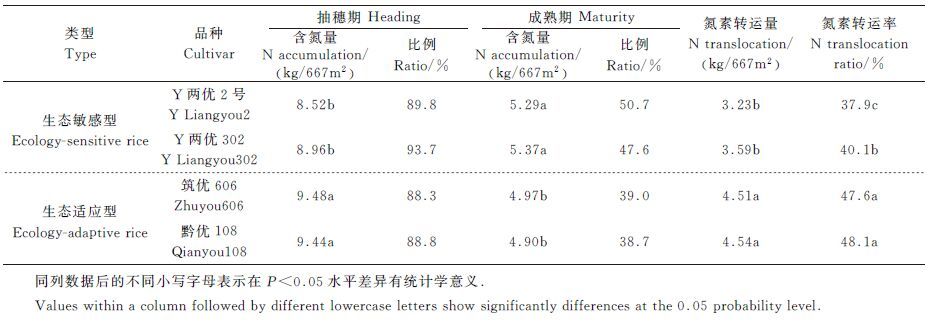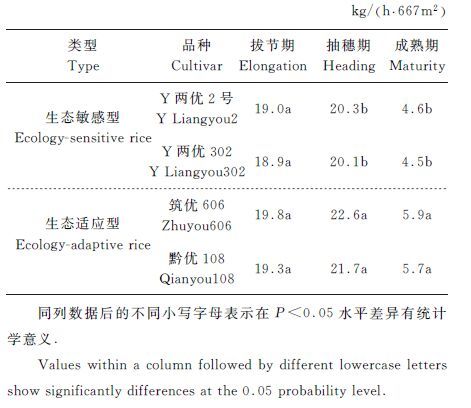| 低温寡日照条件下不同类型杂交稻品种的生态适应性 |
The main objective of this study was to determine the ecological adaptability of different rice cultivars under the low temperature and weak sunshine condition in the middle and late growth duration. Field experiments were conducted in 2013 and 2014 in Guiyang, where was regarded as a representative eco-site with low temperature and weak sunshine, 35 rice genotypes including released cultivars and potential rice combinations were used as a tested materials, and two ecology-adaptive cultivars (Zhuyou606 and Qianyou108) and two ecology-sensitive cultivars (Y Liangyou2 and Y Liangyou302) were selected out as a tested materials to study the differences in grain yield and yield formation, nitrogen accumulation and distribution, root characteristics.
The results showed that: when values were averaged across cultivars and years, compared with the ecology-adaptive cultivars, the ecology-sensitive cultivars obtained a lower grain yield by 13.8%, which was mainly caused by a 9.9% lower filled grain ratio and 15.5% lower 1 000-grain mass. In comparison with the ecology-adaptive cultivars, the ecology-sensitive cultivars achieved 18.8%, 10.8%, 14.5% lower nitrogen accumulation amount at the mid-tillering (critical stage of productive tillering), heading, maturity stage, respectively, resulting in 17.9% lower nitrogen recovery efficiency (RE). Furthermore, a higher nitrogen accumulation amount in stem-leaves at the heading stage and a lower nitrogen accumulation amount in stem-leaves at the maturity stage were found in the ecology-sensitive cultivars, relative to the ecology-adaptive cultivars, and the nitrogen translocation amount from stems and leaves to panicle achieved 3.41 kg/667m2, which was 24.6% lower than that in the ecology-adaptive cultivars,the nitrogen translocation ratio from stems and leaves to panicle achieved 38.55%,which was 19.4% lower than that in the ecology-adaptive cultivars. The root bleeding intensity of ecology-adaptive cultivars achieved 20.2 kg/(h·667m2) at the heading stage and 4.55 kg/(h·667 m2) at the maturity stage, which were 8.8% and 21.6% lower than that in the ecology-adaptive cultivars, respectively.
According to the results, a strategy to increase the grain yield of the ecology-adaptive cultivars is suggested: keeping a higher filled grain ratio and a higher 1 000-grain mass, which are able to be accomplished by increasing nitrogen accumulation during the growth period from heading to maturity. Moreover, these methods such as cultivating strong roots and improving root activity are helpful to increase the amount of nitrogen absorption.
水稻是贵州最主要的粮食作物,近年来,利用自育和引进具有超高产潜力的杂交水稻新品种及栽培技术[1],使我省水稻单产水平不断提高[2, 3].但贵州地理条件较为复杂,低温寡日照生态区域特点明显,较多超高产杂交水稻品种存在生态适应性较差和不同生态区产量表现差异较大的问题[4],限制了超高产品种的大面积推广应用。因此,研究低温寡日照条件下不同类型杂交稻品种的生态适应性具有重要意义。
前人就低温和寡日照对水稻产量形成的影响已进行了大量研究。据李健陵等[5]报道,孕穗期低温使早稻叶绿素含量和光合速率下降,造成光合同化物减少且颖花受精率和可育率下降;傅泰露等[6]研究认为水稻生育中后期低温影响水稻物质积累和籽粒灌浆充实;朱萍等[7]对6个光敏感性不同的杂交稻组合在遮光处理条件下的产量形成进行了研究,表明在遮光条件下产量显著降低,主要原因是降低了结实率和实粒数;秦建权等[8]的研究表明在弱光条件下3个杂交中稻植株对氮的吸收强度及累积量减少且氮素分配比例改变。虽然有关低温和寡日照对水稻生长的影响已各自进行了大量的研究,但在水稻生育中后期低温寡日照综合条件下系统比较研究较少。此外,不同品种的生态适应性存在较大差异,童平等[9]对12个杂交稻品种在2类生态条件下的光合特性及干物质积累进行了研究,结果表明,水稻适应环境的能力主要是由自身因素决定,且品种间存在较大差异。但有关不同温光敏感类型杂交水稻品种对低温寡日照的生态适应性差异却鲜见报道,且差异机制尚不清楚。因此,本研究以贵州近年来选育和引进的不同类型杂交水稻品种为材料,在贵州中部水稻生长中后期低温寡日照生态条件下,研究各品种的产量形成、营养吸收利用、根系生长等特性,以便为超高产杂交水稻合理布局提供参考。
1 材料与方法 1.1 供试材料在前期研究的基础上,选用生态适应型杂交水稻品种(筑优606和黔优108),由贵州省水稻研究所供种;选用生态敏感型杂交水稻品种(Y两优2号和Y两优302),由国家杂交水稻工程技术研究中心供种。4个品种均是杂交籼稻品种(组合),详细信息见表1。
| 表1 4个品种(组合)的基本信息Table 1 Basic information of the four cultivars used in the experiment |
 |
| 点击放大 |
试验于2013年在贵州省水稻研究所实验农场进行(试验地经度为106°39′22″,纬度为26°30′36″,海拔高度为1139 m)。采用随机区组设计,小区面积为15 m2,重复3次,主区间以塑料板材作梗隔离,高度为40 cm,保证各区间单独排灌。4月22日播种,5月22日移栽,栽插规格为30 cm×16.7 cm,每穴栽1苗。施氮总量为15 kg/667 m2,N肥(尿素)分基肥、蘖肥、促花肥、保花肥4次施用,各施25%;P、K肥全部作底肥施用,分别施P2O5和K2O各10 kg/667 m2。试验中各水稻品种同时设置不施氮肥的对照处理,以计算水稻的氮利用率[10],其他管理措施统一按常规栽培要求实施。水稻生长中后期(7—10月上旬)平均温度、日照时数等气象数据由贵州省水稻研究所农业试验气象观测站提供(表2)。水稻生育中后期平均气温较低,日照时数少,具有典型的低温寡日照生态特点。
| 表2 水稻生育中后期试验点气象资料Table 2 Meteorological data of this experimental location after rice elongation |
 |
| 点击放大 |
分别于分蘖中期、拔节期、抽穗期和成熟期每小区按平均茎蘖数取4穴为1个样本,105 ℃下杀青,80 ℃下烘干后称量,并用半微量凯氏定氮法测定其含氮量。
1.3.2 根系性状分别于拔节期、抽穗期和成熟期每小区按平均茎蘖数取4穴为1个样本,按照杨建昌等[11]的方法测定根系伤流强度。
1.3.3 产量的测定成熟期每小区按平均有效穗数取4穴考察穗粒数、每穗颖花数、千粒质量和结实率,并实割100穴测定实际产量。
1.4 数据处理氮肥吸收利用率/%=(施氮区水稻含氮量-空白区水稻含氮量)/施氮量×100;
氮素转运量=抽穗期茎叶含氮量-成熟期茎叶含氮量;
氮素转运率/%=(抽穗期茎叶含氮量-成熟期茎叶含氮量)/抽穗期茎叶含氮量×100。
运用Excel 2007和SPSS 13.0进行数据统计分析。
2 结果与分析 2.1 不同类型水稻品种的产量表3为不同类型杂交稻品种在贵阳点的产量表现,生态敏感型品种的平均产量为719.5 kg/667 m2,生态适应型品种的平均产量为834.2 kg/667 m2,不同类型间差异达显著水平。生态敏感型品种的有效穗数和穗粒数与生态适应型品种差异较小,而结实率和千粒质量分别比生态适应型品种降低了9.9%和15.5%,表明在本试验条件下,生态敏感型品种的产量限制因子是结实率和千粒质量。
| 表3 不同类型水稻品种的产量及产量构成Table 3 Yield and yield formation of rice cultivars with different types |
 |
| 点击放大 |
表4为各生育期2种类型水稻品种的氮素积累量。生态敏感型品种在够苗期、抽穗期和成熟期的氮素积累量分别为2.08 kg/667 m2、9.53 kg/667 m2和10.87 kg/667 m2,与生态适应型品种比较,分别降低了18.8%、10.8%和14.5%,差异均达显著水平,但拔节期的氮素积累量差异较小;生态敏感型品种的氮肥吸收利用率平均为36.0%,较生态适应型品种降低了17.9%,差异达显著水平。
| 表4 不同类型水稻品种氮素积累量及氮肥吸收利用率Table 4 Nitrogen accumulation and recovery efficiency of rice cultivars with different types |
 |
| 点击放大 |
表5为各生育期2种类型水稻品种的氮素转运特性。与生态适应型品种相比,生态敏感型品种抽穗期茎叶含氮量显著降低,抽穗期茎叶含氮量比例有所增加,成熟期的茎叶含氮量和含氮量比例均呈增加趋势。生态敏感型品种的氮素转运量为3.41 kg/667m2,较生态适应型品种降低了24.6%,氮素转运率为38.55%,较生态适应型品种降低了19.4%,差异均达显著水平。
| 表5 不同类型水稻品种的氮素转运特性Table 5 Nitrogentranslocationcharacteristicsofricecultivarswithdifferenttypes |
 |
| 点击放大 |
表6为主要生育期不同水稻品种的根系伤流强度。与生态适应型品种相比,生态敏感型水稻品种的根系伤流强度在拔节期基本相当,抽穗期和成熟期分别为20.2 kg/(h·667 m2)和4.55 kg/(h·667 m2),较生态适应型品种分别降低8.8%和21.6%,且差异均达显著水平。说明抽穗后较低的根系活力是其产量潜力未能充分发挥的重要生理原因。
| 表6 不同类型水稻品种的根系伤流强度Table 6 Root bleeding intensity of rice cultivars with different types |
 |
| 点击放大 |
Y两优2号和Y两优302是具有超高产潜力的杂交水稻品种,均通过国家品种审定委员会审定,前者更是袁隆平院士确定的第3期超级杂交稻攻关的首选品种与农业部认定的超级稻品种,在多地种植均表现出超高产[12, 13]。在本试验条件下,2个品种的产量显著低于生态适应型品种(筑优606、黔优108),其中有效穗数和穗粒数差异不大,而结实率(仅为73%)和千粒质量(仅为24.5 g)均显著降低,说明该类品种在低温寡日照地区(贵阳)的生态适应性不强。据龚金龙等[14]的研究报道,日均温<23 ℃会影响籼稻光合作用和养分输送,灌浆期结实中途停止,水稻不能安全成熟。本试验条件下水稻灌浆期日平均气温低于20 ℃(表2),对水稻正常生长产生了低温胁迫,Y两优2号和Y两优302对低温寡日照生态条件较为敏感,适宜在光热条件较好的区域种植[12, 13];而黔优108和筑优606由于具有较好的耐低温特性故易在本区域获得高产[15]。
氮素是水稻最重要的营养元素,水稻品种的氮素吸收利用与植株生长发育状况密切相关,是影响产量的重要因素[16, 17]。本研究结果表明,与生态适应型品种相比,生态敏感型品种产量降低的主要原因是各生育期的氮素积累量降低,这与殷春渊等[18]报道的高产水稻品种具有更高的氮素积累量的结果较为一致。此外,本研究还表明,生态敏感型水稻品种抽穗至成熟阶段的氮素积累量和氮素转运量均显著降低。据已有研究报道,水稻籽粒灌浆期的营养物质有80%以上来自抽穗后茎秆和叶片的转运[11],且高产水稻和氮高效水稻品种抽穗后均具有较高的氮素转运量[18, 19],由此推测,生态敏感型品种抽穗后氮素营养积累较少,向籽粒转运的氮素营养不足,影响了库容建成和充实,最终降低了产量。由于根系是水稻吸收氮素营养的最重要器官,根系的生长发育状况直接关系水稻的营养吸收和物质积累[11],本结果表明,生态敏感型水稻品种在各生育期的根系伤流强度较低,其中抽穗期和成熟期差异达显著水平,这与其较低的氮素积累量较为一致,说明生育后期根系活力下降可能是影响氮素吸收的重要原因。
| [1] | 周维佳,罗德强,江学海,等.杂交水稻五五精确定量栽培技术规范.贵州农业科学,2012,40(6):55-56. ZHOU W J, LUO D Q, JIANG X H, et al. Rules for five-five precise and quantitative cultivation of hybrid rice.Guizhou Agricultural Sciences, 2012,40(6):55-56. (in Chinese with English abstract) |
| [2] | 张发丽,张恒栋,钱晓刚,等.不同杂交水稻品种高产潜力与主要经济性状关系的研究.湖南农业科学,2013(1):4-6. ZHANG F L, ZHANG H D, QIAN X G, et al. Relationship between high yielding potential and main economic traits of different hybrid rice varieties.Hunan Agricultural Science, 2013(1):4-6. (in Chinese with English abstract) |
| [3] | 周应友,陈德珍.遵义县水稻精确定量栽培高产攻关试验示范成效分析.耕作与栽培,2012(6):22-23. ZHOU Y Y, CHEN D Z. The high yield research and demonstration of rice precise and quantitative cultivation.Planting and Cultivation, 2012(6):22-23. (in Chinese with English abstract) |
| [4] | 罗德强,王绍华,江学海,等.精确定量施肥对贵州高原山区杂交籼稻产量与群体质量的影响.中国农业科学,2014,47(11):2099-2108. LUO D Q, WANG S H, JIANG X H, et al. Effect of accurate fertilizer model on yield and population quality of hybrid indica rice cultivars in Guizhou highland area.Scientia Agricultura Sinica, 2014,47(11):2099-2108. (in Chinese with English abstract) |
| [5] | 李健陵,霍治国,吴丽姬,等.孕穗期低温对水稻产量的影响及其生理机制.中国水稻科学,2014,28(3):277-288. LI J L,HUO Z G, WU L J, et al. Effects of low temperature on grain yield of rice and its physiological mechanism at the booting stage.Chinese Journal of Rice Science, 2014,28(3):277-288. (in Chinese with English abstract) |
| [6] | 傅泰露,马均,王贺正,等.水稻开花期耐冷性综合评价及鉴定指标的筛选.西南农业学报,2007,20(5):966-969. FU T L, MA J, WANG H Z, et al. Comprehensive evaluation and screening identification indexes of clod tolerance at flowering stage in rice.Southwest China Journal of Agricultural Sciences, 2007,20(5):966-969. (in Chinese with English abstract) |
| [7] | 朱萍,杨世民,马均,等.遮光对杂交水稻组合生育后期光合特性和产量的影响.作物学报,2008,34(11):2003-2009. ZHU P, YANG S M, MA J, et al. Effect of shading on the photosynthetic characteristics and yield at later growth stage of hybrid rice combination.Acta Agronomica Sinica, 2008,34(11):2003-2009. (in Chinese with English abstract) |
| [8] | 秦建权,唐启源,李迪秦,等. 抽穗后光照强度对超级杂交稻干物质生产及氮素吸收与分配的影响.四川农业大学学报,2010,28(1):28-34. QIN J Q, TANG Q Y, LI T Q, et al. Effect of different light intensity after heading stage on dry matter accumulation and nitrogen uptake and distribution of super hybrid rice.Journal of Sichuan Agricultural University, 2010,28(1):28-34. (in Chinese with English abstract) |
| [9] | 童平,杨世民,马均,等.不同水稻品种在不同光照条件下的光和特性和干物质积累.应用生态学报,2008,19(3):505-511. TONG P, YANG S M, MA J, et al. Photosynthetic characteristics and dry matter accumulation of hybrid rice varieties under different light conditions.Chinese Journal of Applied Ecology, 2008,19(3):505-511. (in Chinese with English abstract) |
| [10] | 李敏,张洪程,李国业,等.水稻氮效率基因型差异及其机理研究进展.核农学报,2011,25(5):1057-1063. LI M, ZHANG H C, LI G Y, et al. Genotypic difference in nitrogen use efficiency in rice and its morphological and physiological mechanisms.Journal of Nuclear Agricultural Sciences, 2011,25(5):1057-1063. (in Chinese with English abstract) |
| [11] | 杨建昌.水稻根系形态生理与产量、品质形成及养分吸收利用的关系.中国农业科学,2011,44(1):36-46. YANG J C. Relationships of rice root morphology and physiology with the formation of grain yield and quality and the nutrient absorption and utilization.Scientia Agricultura Sinica, 2011,44(1):36-46. (in Chinese with English abstract) |
| [12] | 李启标,陈嗣建,胡伟民,等.杂交稻Y两优2号、Y两优302示范表现及栽培技术.广东农业科学,2012,39(9):18-19. LI Q B, CHEN S J, HU W M, et al. The high yield performance and cultivation technique of hybrid rice Y Liangyou2 and Y Liangyou302.Guangdong Agricultural Sciences, 2012,39(9):18-19. (in Chinese with English abstract) |
| [13] | 胡朝生,李蔚,李莉,等.强优势杂交中籼“Y两优2号”特性特征表现.安徽科技,2011(6):2. HU Z S, LI W, LI L. et al. The traits and characteristics of hybrid rice “Y Liangyou2” with middle growth duration. Anhui Science & Technology, 2011(6):2.(in Chinese) |
| [14] | 龚金龙,张洪程,胡雅杰,等.灌浆结实期温度对水稻产量和品质形成的影响.生态学杂志,2013,32(2):482-491. GONG J L, ZHANG H C, HU Y J. et al.Effects of air temperature during rice grain-filling period on the formation of rice grain yield and its quality. Chinese Journal of Ecology, 2013,32(2):482-491. (in Chinese with English abstract) |
| [15] | 黄培英,王际凤,朱速松,等.高产稳产杂交水稻新组合汕优108.杂交水稻,2014,168(5):81-82. HUANG P Y, WANG J F, ZHU S S, et al. Shanyou 108, a new high-yielding hybrid rice combination.Hybrid Rice, 2014,168(5):81-82. (in Chinese with English abstract) |
| [16] | SINGH U, LAGHA J K, CASTILLO E G, et al. Genotypic variation in nitrogen use efficiency in medium and long duration rice.Field Crops Research, 1998,58:35-53. |
| [17] | KOUTROUBASA S D, NTANOSB D A. Genotypic differences for grain yield and nitrogen utilization in Indica and Japonica rice under Mediterranean conditions.Field Crops Research, 2003,83:251-260. |
| [18] | 殷春渊,张庆,魏海燕,等.不同产量类型水稻基因型氮素吸收、利用效率的差异.中国农业科学,2010,43(1):39-50. YIN C Y, ZHANG Q, WEI H Y, et al. Differences in nitrogen absorption and use efficiency in rice genotypes with different yield performance.Scientia Agricultura Sinica, 2010,43(1):39-50. (in Chinese with English abstract) |
| [19] | PENG S, BURESH R J, HUANG J, et al. Strategies for overcoming low agronomic nitrogen use efficiency in irrigated rice systems in China. Field Crops Research, 2006,96:37-47. |
 2016, Vol. 42
2016, Vol. 42


